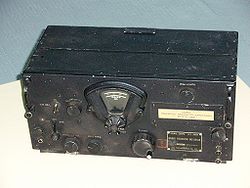The BC-348 is an American-made communications receiver, which was mass-produced during World War II for the U.S. Army Air Force. Under the joint Army-Navy nomenclature system, the receiver system became known as the AN/ARR-11.
Contents


The BC-348 is an American-made communications receiver, which was mass-produced during World War II for the U.S. Army Air Force. Under the joint Army-Navy nomenclature system, the receiver system became known as the AN/ARR-11.


The BC-348 is the 28 vdc powered version of the 14 vdc powered BC-224. The first version, the BC-224-A, was produced in 1936. [1] Installed in almost all USAAF multi-engined transports and bombers used during the fifteen-year period from before World War II through the Korean War, BC-348 radio receivers were easy to operate and reliable. They were also installed in some similar USN, British, and Canadian aircraft. Designed as LF/MF/HF receivers for use in larger aircraft (B-17, B-24, B-25, B-26, B-29, C-47, etc.), they were initially paired with a BC-375 transmitter in the SCR-287-A system. Late in World War II, the AN/ARR-11 (BC-348) was the receiver and the AN/ART-13A was the transmitter in the AN/ARC-8 system. They were also used in some ground and mobile installations such as the AN/MRC-20. [2] The BC-348 series ran through several variations during its long production history, which included the BC-224. More than 100,000 of these receivers were produced, 80 percent by Belmont Radio and Wells-Gardner and the balance by RCA and Stromberg-Carlson.

BC-348 receivers were copied and manufactured by the U.S.S.R. following War II, by the Russian Vefon Works and labeled УС-9 (US-9 in English) The УС-9 continued to be produced in the Soviet Union through the 1970s, with such improvements as a solid state inverter to replace the dynamotor. [3]
Enola Gay, the B-29 Superfortress bomber that dropped "Little Boy", the first atomic bomb on Hiroshima, Japan, was equipped with a BC-348 receiver as part of the aircraft's AN/ARC-8 system. [4] Today, many examples of the BC-348 are restored and operated by vintage and military amateur radio enthusiasts. [5]
The AN/ARC-8 system was still in service in older USAF aircraft in the early 1970s. At that time, military surplus dealers near Davis-Monthan Air Force Base in Tucson, Arizona, had stacks of the BC-348, that had been removed from aircraft, for sale to the public.[ citation needed ]

The BC-224-A, -B, -C, and -D, and the BC-348-B, and -C, tuned 1.5-18 MHz in six bands. The Signal Corps had the receiver design modified to add a 200-500 kHz band and compress the 1.5-18 MHz coverage into the remaining five bands. This modified design became the BC-224-E and the BC-348-E. The 200–500 kHz and 1.5-18 MHz tuning range remained constant for subsequent production of all models. [3]